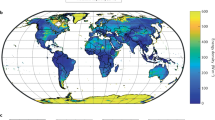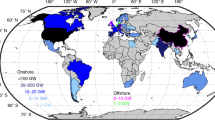Abstract
The capacity factor (cf) is a critical variable for quantifying wind turbine efficiency. Climate change-induced wind resource variations and technical wind turbine fleet development will alter future cfs. Here we define 12 techno-climatic change scenarios to assess regional and global onshore cfs in 2021–2060. Despite a decreasing global wind resource, we find an increase in future global cf caused by fleet development. The increase is significant under all evaluated techno-climatic scenarios. Under the likely emissions scenario Shared Socioeconomic Pathway 2–4.5, global cf increases from 0.251 in 2021 up to 0.310 in 2035 under ambitious fleet development. This cf enhancement is equivalent to a 361 TWh yield improvement under the globally installed capacity of 2020 (698 GW). To increase the contribution of the future wind turbine fleet to the Intergovernmental Panel on Climate Change climate protection goals, we recommend a rapid wind turbine fleet conversion.
This is a preview of subscription content, access via your institution
Access options
Access Nature and 54 other Nature Portfolio journals
Get Nature+, our best-value online-access subscription
$29.99 / 30 days
cancel any time
Subscribe to this journal
Receive 12 digital issues and online access to articles
$119.00 per year
only $9.92 per issue
Buy this article
- Purchase on Springer Link
- Instant access to full article PDF
Prices may be subject to local taxes which are calculated during checkout







Similar content being viewed by others
Data availability
The datasets analysed and generated during the current study are included in the paper and its Supplementary Information. An Excel spreadsheet containing the scenario internal uncertainties, validation results, the detrended cf annual means for each GCM and the PHC combinations and their power curves is available as Supplementary Data 1. CMIP6 simulations are available at: https://cds.climate.copernicus.eu/cdsapp#!/dataset/projections-cmip6?tab=form. Source data are provided with this paper.
Code availability
A Matlab code regarding cf estimation is available. A Matlab code regarding bias correction is not publicly available due to the large data size of the required GloWiSMo input data but is available upon reasonable request from the authors.
References
Glasgow Climate Pact (UNFCC, 2021); https://unfccc.int/sites/default/files/resource/cma2021_L16_adv.pdf
Statistical Review of World Energy 2021 (BP, 2021); https://www.bp.com/content/dam/bp/business-sites/en/global/corporate/pdfs/energy-economics/statistical-review/bp-stats-review-2021-full-report.pdf
Renewable Energy Statistics 2021 (International Renewable Energy Agency, 2021); https://irena.org/-/media/Files/IRENA/Agency/Publication/2021/Aug/IRENA_Renewable_Energy_Statistics_2021.pdf
Zeng, Z. et al. A reversal in global terrestrial stilling and its implications for wind energy production. Nat. Clim. Change 9, 979–985 (2019).
Rinne, E., Holttinen, H., Kiviluoma, J. & Rissanen, S. Effects of turbine technology and land use on wind power resource potential. Nat. Energy 3, 494–500 (2018).
Karnauskas, K. B., Lundquist, J. K. & Zhang, L. Southward shift of the global wind energy resource under high carbon dioxide emissions. Nat. Geosci. 11, 38–43 (2018).
Jung, C. & Schindler, D. Changing wind speed distributions under future global climate. Energy Convers. Manag. 198, 111841 (2019).
Carvalho, D., Rocha, A., Costoya, X., deCastro, M. & Gómez-Gesteira, M. Wind energy resource over Europe under CMIP6 future climate projections: what changes from CMIP5 to CMIP6. Renew. Sustain. Energy Rev. 151, 111594 (2021).
Sherman, P., Chen, X. & McElroy, M. B. Wind-generated electricity in China: decreasing potential, inter-annual variability and association with changing climate. Sci. Rep. 7, 16294 (2017).
Pryor, S. C., Barthelmie, R. J., Bukovsky, M. S., Leung, L. R. & Sakaguchi, K. Climate change impacts on wind power generation. Nat. Rev. Earth Environ. 1, 627–643 (2020).
Zhuo, C. et al. Changes in wind energy potential over China using a regional climate model ensemble. Renew. Sustain. Energy Rev. 159, 112219 (2022).
Bloomfield, H. C. et al. Quantifying the sensitivity of European power systems to energy scenarios and climate change projections. Renew. Energy 164, 1062–1075 (2021).
Hausfather, Z. & Peters, G. Emissions—the ‘business as usual’ story is misleading. Nature 577, 618–620 (2020).
Jung, C. & Schindler, D. Distance to power grids and consideration criteria reduce global wind energy potential the most. J. Clean. Prod. 317, 128472 (2021).
Eurek, K. et al. An improved global wind resource estimate for integrated assessment models. Energy Econ. 64, 552–567 (2017).
Pryor, S. C. & Barthelmie, R. J. A global assessment of extreme wind speeds for wind energy applications. Nat. Energy 6, 268–276 (2021).
Kitzing, L., Jensen, M. K., Telsnig, T. & Lantz, E. Multifaceted drivers for onshore wind energy repowering and their implications for energy transition. Nat. Energy 5, 1012–1021 (2020).
Reyers, M., Moemken, J. & Pinto, J. G. Future changes of wind energy potentials over Europe in a large CMIP5 multi‐model ensemble. Int. J. Climatol. 36, 783–796 (2016).
Meehl, G. A., Boer, G. J., Covey, C., Latif, M. & Stouffer, R. J. The Coupled Model Intercomparison Project (CMIP). Bull. Am. Meteor. 81, 313–318 (2000).
Jung, C. & Schindler, D. Integration of small-scale surface properties in a new high resolution global wind speed model. Energy Convers. Manag. 210, 112733 (2020).
Tapetado, P., Victoria, M., Greiner, M. & Usaola, J. Exploring backup requirements to complement wind, solar and hydro generation in a highly renewable Spanish power system. Energy Strategy Rev. 38, 100729 (2021).
Jung, C. & Schindler, D. On the inter-annual variability of wind energy generation—a case study from Germany. Appl. Energy 230, 845–854 (2018).
Vautard, R., Cattiaux, J., Yiou, P., Thépaut, J. N. & Ciais, P. Northern Hemisphere atmospheric stilling partly attributed to an increase in surface roughness. Nat. Geosci. 3, 756–761 (2010).
Jung, C., Schindler, D. & Grau, L. Achieving Germany’s wind energy expansion target with an improved wind turbine siting approach. Energy Convers. Manag. 173, 383–398 (2018).
Diyoke, C. A new approximate capacity factor method for matching wind turbines to a site: case study of Humber region, UK. Int. J. Energy Environ. 10, 451–462 (2019).
Jung, C. & Schindler, D. A global wind farm potential index to increase energy yields and accessibility. Energy 231, 120923 (2021).
Future of Wind (International Renewable Energy Agency, 2019).
Firestone, J. & Kirk, H. A strong relative preference for wind turbines in the United States among those who live near them. Nat. Energy 4, 311–320 (2019).
Jacobson, M. Z. & Archer, C. L. Saturation wind power potential and its implications for wind energy. Proc. Natl Acad. Sci. USA 109, 15679–15684 (2012).
Li, Y., Huang, X., Tee, K. F., Li, Q. & Wu, X. P. Comparative study of onshore and offshore wind characteristics and wind energy potentials: a case study for southeast coastal region of China. Sustain. Energy Technol. Assess. 39, 100711 (2020).
Costoya, X., DeCastro, M., Carvalho, D. & Gómez-Gesteira, M. On the suitability of offshore wind energy resource in the United States of America for the 21st century. Appl. Energy 262, 114537 (2020).
Hoen, B. D. et al. United States Wind Turbine Database (US Geological Survey, American Clean Power Association & Lawrence Berkeley National Laboratory, 2020); https://www.sciencebase.gov/catalog/item/57bdfd8fe4b03fd6b7df5ff9
Grau, L., Jung, C. & Schindler, D. Sounding out the repowering potential of wind energy—a scenario-based assessment from Germany. J. Clean. Prod. 293, 126094 (2021).
Canadian Wind Turbine Database (Government of Canada, 2020); https://open.canada.ca/data/en/dataset/79fdad93-9025-49ad-ba16-c26d718cc070
Global Wind Report, Annual Market Update 2017 (Global Wind Energy Council, 2018); https://gwec.net/wp-content/uploads/2020/11/GWEC_Global_Wind_2017_Report.pdf
IEA Wind Technology Collaboration Programme (International Energy Agency Wind Technology Collaboration Programme, 2020); https://iea-wind.org/wp-content/uploads/2020/12/Annual-Report-2017.pdf
Dunnett, S., Sorichetta, A., Taylor, G. & Eigenbrod, F. Harmonised global datasets of wind and solar farm locations and power. Sci. Data 7, 130 (2020).
Marktstammdatenregister (Bundesnetzagentur/Federal Network Agency, 2022); https://www.marktstammdatenregister.de/MaStR/Einheit/Einheiten/OeffentlicheEinheitenuebersicht
Jung, C. & Schindler, D. A review of recent studies on wind resource projections under climate change. Renew. Sustain. Energy Rev. 165, 112596 (2022).
Costoya, X., Rocha, A. & Carvalho, D. Using bias-correction to improve future projections of offshore wind energy resource: a case study on the Iberian Peninsula. Appl. Energy 262, 114562 (2020).
Jung, C. & Schindler, D. Introducing a new approach for wind energy potential assessment under climate change at the wind turbine scale. Energy Convers. Manag. 225, 113425 (2020).
Gualtieri, G. A. Comprehensive review on wind resource extrapolation models applied in wind energy. Renew. Sust. Energy Rev. 102, 215–233 (2019).
Stull R. B. Practical Meteorology: An Algebra-Based Survey of Atmospheric Science (Sundog Publishing, 2018).
Wind Turbine Library (Reiner Lemoine Institut, 2019); https://openenergy-platform.org/dataedit/view/supply/wind_turbine_library
The Economics of Wind Energy (European Wind Energy Association, 2009); https://www.ewea.org/fileadmin/files/library/publications/reports/Economics_of_Wind_Energy.pdf
Wilcoxon, F. Individual comparisons by ranking methods. Biometrics 1, 80–83 (1945).
Dix, M. et al. ACCESS-CM2 Model Output Prepared for CMIP6 (Commonwealth Science and Industrial Research Organisation, 2019); https://doi.org/10.22033/ESGF/CMIP6.4239
Ziehn, T. et al. ACCESS-ESM1.5 Model Output Prepared for CMIP6 (Commonwealth Science and Industrial Research Organisation, 2019); https://doi.org/10.22033/ESGF/CMIP6.2288
Swart, N. C. et al. CanESM5 Model Output Prepared for CMIP6 (Canadian Centre for Climate Modelling and Analysis, 2019); https://doi.org/10.22033/ESGF/CMIP6.1317
Danabasoglu, G. CESM2-WACCM Model Output Prepared for CMIP6 (National Center for Atmospheric Research, 2019); https://doi.org/10.22033/ESGF/CMIP6.10024
Fogli, P. G., Iovino, D. & Lovato, T. CMCC-CM2-SR5 Model Output Prepared for CMIP6 (Euro-Mediterranean Center on Climate Change, 2020); https://doi.org/10.22033/ESGF/CMIP6.13162
Peano, D., Lovato, T. & Materia, S. CMCC-ESM2 Model Output Prepared for CMIP6 (Euro-Mediterranean Center on Climate Change, 2020); https://doi.org/10.22033/ESGF/CMIP6.13165
EC-Earth3 Model Output Prepared for CMIP6 (EC-Earth Consortium, 2019); https://doi.org/10.22033/ESGF/CMIP6.181
Li, L. FGOALS-g3 Model Output Prepared for CMIP6 (Institute of Atmospheric Physics of Chinese Academy of Science, 2019); https://doi.org/10.22033/ESGF/CMIP6.2056
Prajesh, A. G. et al. IITM-ESM Model Output Prepared for CMIP6 (Indian Institute of Tropical Meteorology, 2019); https://doi.org/10.22033/ESGF/CMIP6.44
Volodin, E. et al. INM-CM4-8 Model Output Prepared for CMIP6 (Institute of Numerical Mathematics, 2019); https://doi.org/10.22033/ESGF/CMIP6.12321
Volodin, E. et al. INM-CM5-0 Model Output Prepared for CMIP6 (Institute of Numerical Mathematics, 2019); https://doi.org/10.22033/ESGF/CMIP6.12322
Boucher, O. et al. IPSL-CM6A-LR Model Output Prepared for CMIP6 (Institut Pierre-Simon Laplace, 2018); https://doi.org/10.22033/ESGF/CMIP6.1534
Shiogama, H., Abe, M. & Tatebe, H. MIROC MIROC6 Model Output Prepared for CMIP6 (Japanese Modeling Community, 2019); https://doi.org/10.22033/ESGF/CMIP6.898
von Storch, J.-S. et al. MPIESM1.2-HR Model Output Prepared for CMIP6 (Max Planck Institute for Meteorology, 2017); https://doi.org/10.22033/ESGF/CMIP6.762
Jungclaus, J. et al. MPIESM1.2-LR Model Output Prepared for CMIP6 (Max Planck Institute for Meteorology, 2019); https://doi.org/10.22033/ESGF/CMIP6.787
Yukimoto, S. et al. MRI-ESM2.0 Model Output Prepared for CMIP6 (Meteorological Research Institute, 2019); https://doi.org/10.22033/ESGF/CMIP6.621
Seland, Ø. et al. NorESM2-LM Model Output Prepared for CMIP6 (Norwegian Climate Center, 2019); https://doi.org/10.22033/ESGF/CMIP6.502
Bentsen, M. et al. NorESM2-MM Model Output Prepared for CMIP6 (Norwegian Climate Center, 2019); https://doi.org/10.22033/ESGF/CMIP6.506
Author information
Authors and Affiliations
Contributions
C.J.: conceptualization, data curation, formal analysis, methodology, project administration, supervision, validation, visualization, writing—original draft preparation. D.S.: resources, validation, supervision, visualization, writing—review and editing.
Corresponding author
Ethics declarations
Competing interests
The authors declare no competing interests.
Peer review
Peer review information
Nature Energy thanks Hannah Bloomfield, Edgar Hertwich and Jianlei Mo for their contribution to the peer review of this work.
Additional information
Publisher’s note Springer Nature remains neutral with regard to jurisdictional claims in published maps and institutional affiliations.
Supplementary information
Supplementary Information
Supplementary Fig. 1.
Supplementary Table 1
Supplementary tables.
Source data
Source Data Fig. 1
GeoTiff for Fig. 1.
Source Data Fig. 2
Statistical source data for Fig. 2.
Source Data Fig. 3
Statistical source data for Fig. 3.
Source Data Fig. 4
Statistical source data for Fig. 4.
Source Data Fig. 5
Statistical source data for Fig. 5.
Source Data Fig. 6
Statistical source data for Fig. 6.
Source Data Fig. 7
Statistical source data for Fig. 7.
Rights and permissions
About this article
Cite this article
Jung, C., Schindler, D. Development of onshore wind turbine fleet counteracts climate change-induced reduction in global capacity factor. Nat Energy 7, 608–619 (2022). https://doi.org/10.1038/s41560-022-01056-z
Received:
Accepted:
Published:
Issue Date:
DOI: https://doi.org/10.1038/s41560-022-01056-z



